
H. P. Lovecraft Locations in Providence
Actual Locations in Providence Used As Settings by H. P. Lovecraft
Lovecraft made many references to Providence locations in his writing. In a few cases he used the actual street addresses. In other cases he described the inspirations in the enormous number of letters he wrote to friends and other writers. The John Hay Library at Brown University has a collection with many, but obviously not all, of the letters he wrote. He is estimated to have written from 80,000 to 100,000 letters, far more writing than the total of all his fiction and essays.
In his 1926 story "The Call of Cthulhu", the narrator's great-uncle, who is the real protagonist of much of the story, is named George Gammell Angell. He is described as Professor Emeritus of Semitic Languages at Brown University.
Angell Street is the main east-to-west one-way street through the College Hill area of Providence, running along the north side of the Brown University campus. Waterman Street, one block to its south, is the corresponding west-to-east street. Presumably the character is meant to be of a prominent local family, the namesake of the street.
276 Angell Street
Lovecraft described the Hamilton House at 276 Angell Street as the "sumptuous but hideous French-roofed mansion" named as "the Archer Harris House" in his story "The Shunned House". Lovecraft had strong opinions about architecture and people — they should be entirely white and English. Well, the buildings didn't have to be white. But the people did. And preferably, English.
Lovecraft described this as having been built in 1876, but it was actually built in the early 20th century. Now it's a learning center for retirees.

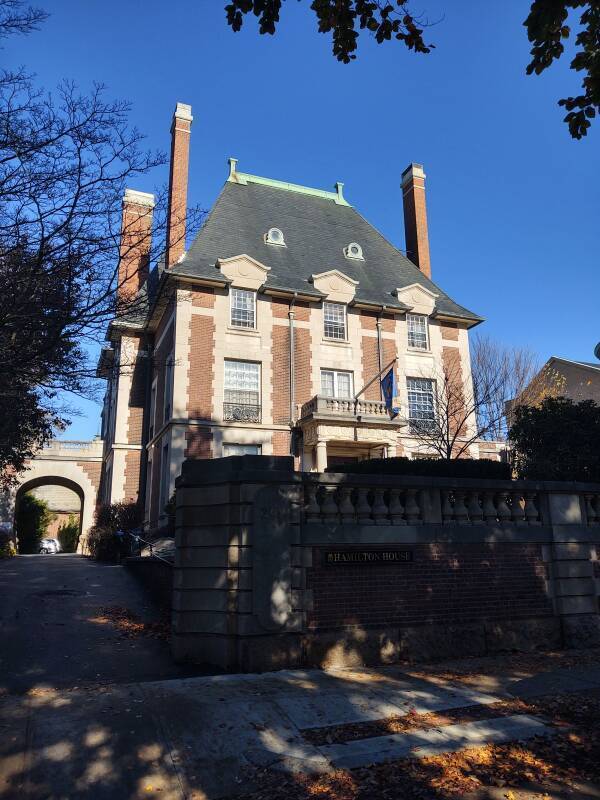
William Harris, at last thoroughly convinced of the radically unhealthy nature of his abode, now took steps toward quitting it and closing it forever. Securing temporary quarters for himself and his wife at the newly opened Golden Ball Inn, he arranged for the building of a new and finer house in Westminster Street, in the growing part of the town across the Great Bridge. There, in 1785, his son Dutee was born; and there the family dwelt till the encroachments of commerce drove them back across the river and over the hill to Angell Street, in the newer East Side residence district, where the late Archer Harris built his sumptuous but hideous French-roofed mansion in 1876.
— "The Shunned House", 1924, published in Weird Tales, October 1937.
Golden Ball Inn
As for the Golden Ball Inn, mentioned above, it used to be at the southeast corner of Benefit Street and South Court Street. It was torn down before the late 1970s. It stood between the red brick building at immediate right and the green building further down Benefit Street.
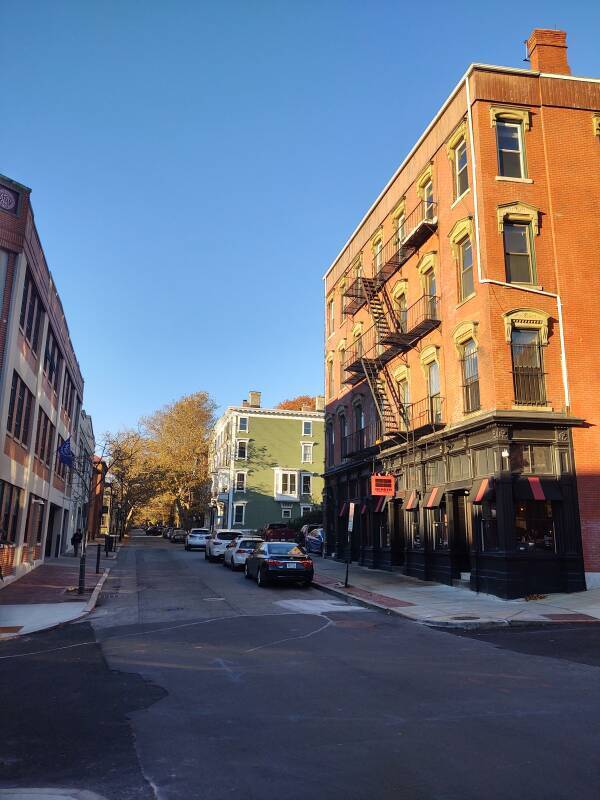
The former site of the Golden Ball Inn is now a parking lot.

Lovecraft poured out his dislike of the nearby Colonial Apartments building, new in his time, in letters to friends. Now it seems to be occupied mostly by Brown University students.
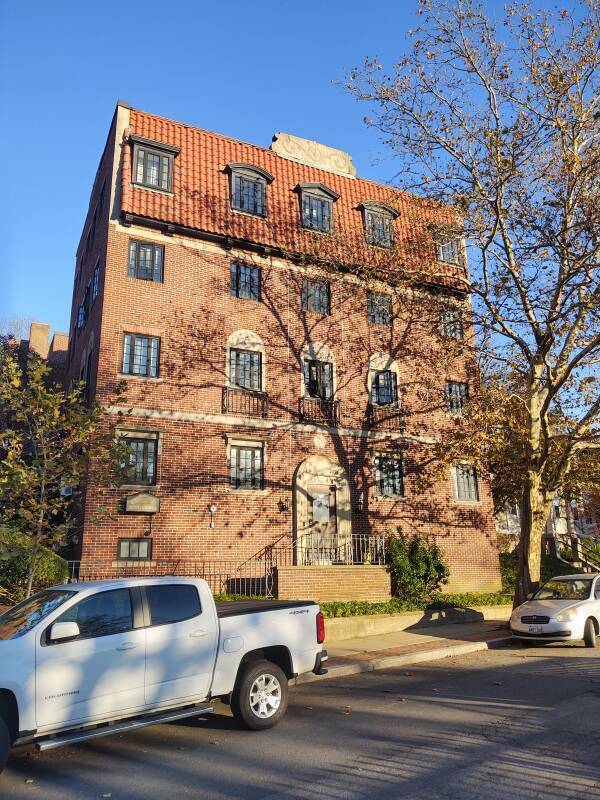
7 Thomas Street
Lovecraft hated the early Arts and Crafts design of the Fleur-de-Lys Studios, built in 1885 at 7 Thomas Street. However, he used it as the home of a character in "The Call of Cthulhu".
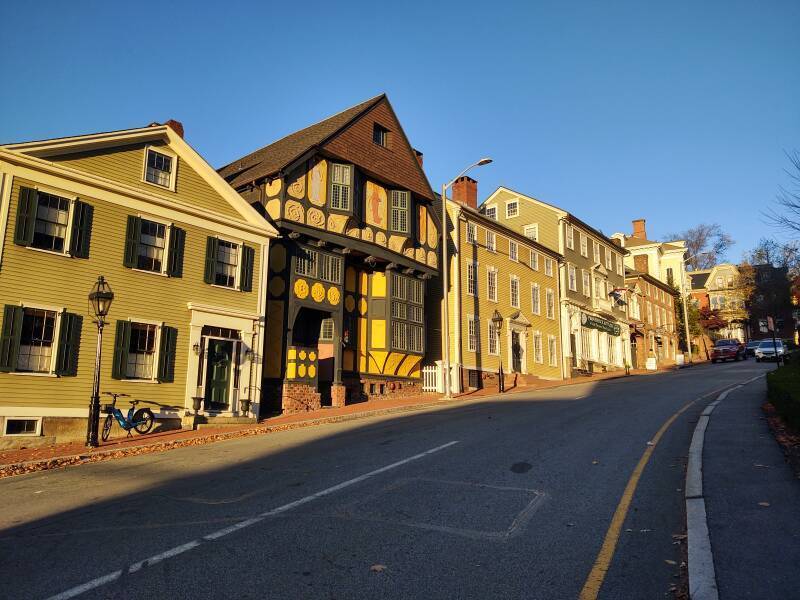
His card bore the name of Henry Anthony Wilcox, and my uncle had recognised him as the youngest son of an excellent family slightly known to him, who had latterly been studying sculpture at the Rhode Island School of Design and living alone in the Fleur-de-Lys building near that institution.
The bas-relief was a rough rectangle less than an inch thick and about five by six inches in area... It seemed to be a sort of monster, or symbol representing a monster, of a form which only a diseased fancy could conceive. If I say that my somewhat extravagant imagination yielded simultaneous pictures of an octopus, a dragon, and a human caricature, I shall not be unfaithful to the spirit of the thing. A pulpy, tentacled head surmounted a grotesque and scaly body with rudimentary wings; but it was the general outline of the whole which made it most shockingly frightful.
[...]
Wilcox still lived alone in the Fleur-de-Lys building in Thomas Street, a hideous Victorian imitation of seventeenth century Breton Architecture which flaunts its stuccoed front amidst the lovely colonial houses on the ancient hill, and under the very shadow of the finest Georgian steeple in America. I found him at work in his rooms, and at once concluded from the specimens scattered about that his genius is indeed profound and authentic. He will, I believe, some time be heard from as one of the great decadents; for he has crystallised in clay and will one day mirror in marble those nightmares and phantasies which Arthur Machen evokes in prose, and Clark Ashton Smith makes visible in verse and in painting.
— "The Call of Cthulhu", 1926, published in Weird Tales, February 1928.
The H. P. Lovecraft Historic Society made a movie based on that story. It includes a scene shot here. The building itself has bas-relief decoration. But none with tentacled monsters.
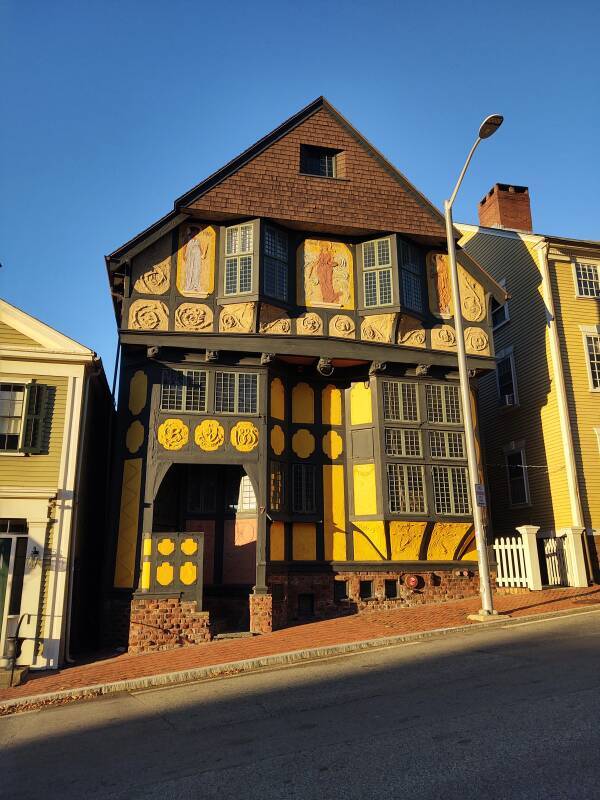


11 Thomas Street
Lovecraft frequently visited the Providence Art Club and he mentioned in letters that his aunt's paintings had been exhibited there. It's just two doors up the hill from the Fleur-de-Lys Studios, at 11 Thomas Street, in two structures dating to 1786 and 1791. He mentioned it in a letter.
My mother is a landscape painter of no little skill, whilst my eldest aunt is still more expert in this direction, having had canvases hung in exhibitions at the Providence Art Club.
Here it is in the late afternoon and then in the evening:

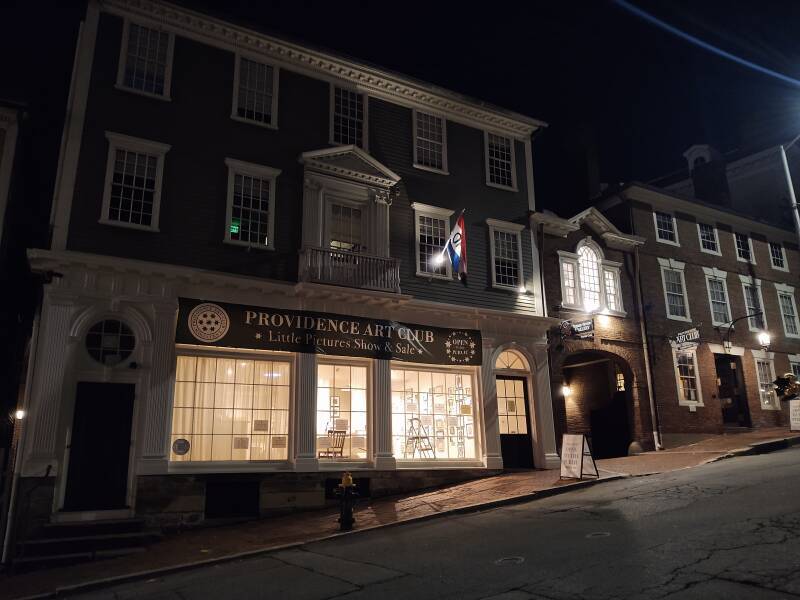
144 Benefit Street
144 Benefit Street was described in "The Shunned House" as the home of Dr. Elihu Whipple, an uncle of the narrator.
Dr. Whipple was a sane, conservative physician of the old school. [...] He lived with one man-servant in a Georgian homestead with knocker and iron-railed steps, balanced eerily on a steep ascent of North Court Street beside the ancient brick court and colony house where his grandfather—a cousin of that celebrated privateersman, Capt. Whipple, who burnt His Majesty’s schooner Gaspee in 1772—had voted in the legislature on May 4, 1776, for the independence of the Rhode-Island Colony.
— "The Shunned House", 1924, published in Weird Tales, October 1937.
It's now The Old Court bed and breakfast:

133 / 135 Benefit Street
A short distance north is 133 Benefit Street, which seems to have been re-numbered 135. It was built in or around 1763. Lovecraft's elderly aunt Lillian lived here from 1919 to 1920 as a companion to Mrs. H. C. Babbit. Four years later, he used it as the location for the "Stephen Harris House" in "The Shunned House". The story is partially based around a house in New Jersey that Lovecraft had heard about, in which a remarkable number of residents died. The story explains accurately that the house lies between the home of Poe's girlfriend and brief fiancée, Sarah Helen Whitman, and where Poe stayed while visiting.
From even the greatest of horrors irony is seldom absent. Sometimes it enters directly into the composition of the events, while sometimes it relates only to their fortuitous position among persons and places. The latter sort is splendidly exemplified by a case in the ancient city of Providence, where in the late forties Edgar Allan Poe used to sojourn often during his unsuccessful wooing of the gifted poetess, Mrs. Whitman. Poe generally stopped at the Mansions House in Benefit Street—the renamed Golden Ball Inn whose roof has sheltered Washington, Jefferson, and Lafayette—and his favorite walk led northward along the same street to Mrs. Whitman's home and the neighboring hillside churchyard of St. John's whose hidden expanse of eighteenth-century gravestones had for him a peculiar fascination.
Now the irony is this. In this walk, so many times repeated, the world's greatest master of the terrible and the bizarre was obliged to pass a particular house on the eastern side of the street; a dingy, antiquated structure perched on the abruptly rising side hill, with a great unkempt yard dating from a time when the region was partly open country. It does not appear that he ever wrote or spoke of it, nor is there any evidence that he even noticed it. And yet that house, to the two persons in possession of certain information, equals or outranks in horror the wildest phantasy of the genius who so often passed it unknowingly, and stands starkly leering as a symbol of all that is unutterably hideous.
The house was—and for that matter still is—of a kind to attract the attention of the curious. Originally a farm or semi-farm building, it followed the average New England colonial lines of the middle eighteenth century—the prosperous peaked-roof sort, with two stories and dormerless attic, and with the Georgian doorway and interior panelling dictated by the progress of taste at that time. It faced south, with one gable and buried to the lower windows in the eastward rising hill, and the other exposed to the foundations toward the street. Its construction, over a century and a half ago, had followed the grading and straightening of the road in that especial vicinity; for Benefit Street—at first called Back Street—was laid out as a lane winding amongst the graveyards of the first settlers, and straightened only when the removal of the bodies to the North Burial Ground made it decently possible to cut through the old family plots.
— "The Shunned House", 1924, published in Weird Tales, October 1937.
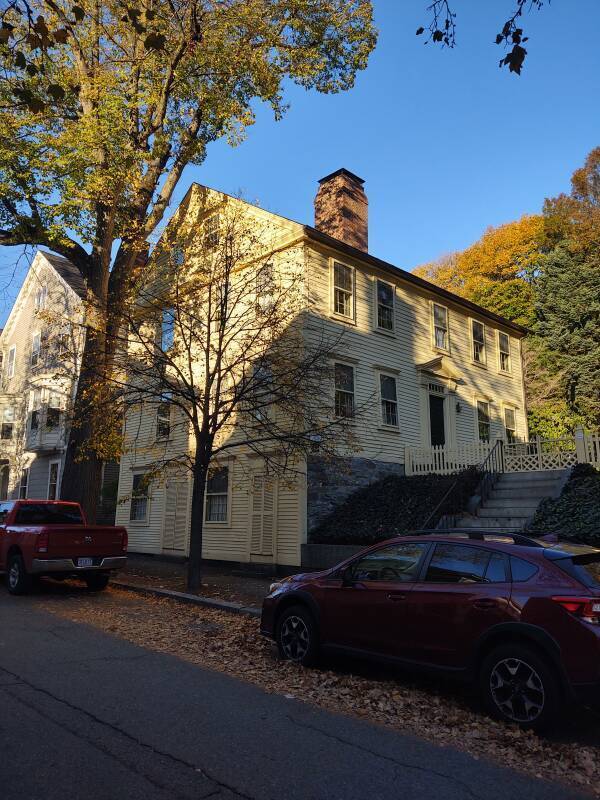
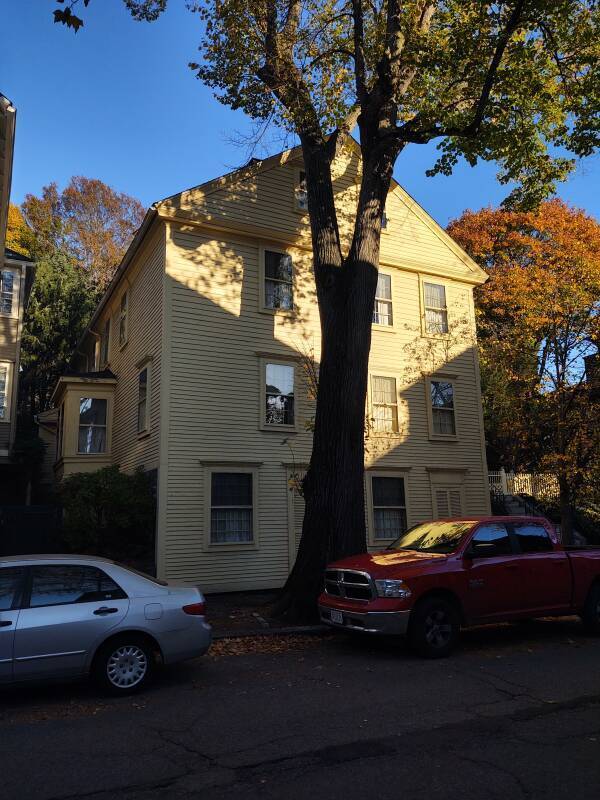
140 Prospect Street
The Halsey Mansion at 140 Prospect Street was just around the corner from Lovecraft's home at 10 Barnes Street.

Colonel Thomas Lloyd Halsey amassed a large fortune. Then his son and namesake went to Buenos Aires, Argentina, as the agent for the Brown and Ives firm. He wrote back to the company complaining that the local officials would not stay bribed, requiring multiple "donations" during any transaction.
In 1912 he became the U.S. Consul in Buenos Aires, amassed a fortune of his own, and took on either a mistress or common-law wife by whom he had a daughter. He later moved back to Providence.
His will left this property to his sister only if his grandson in Argentina didn't move to Providence and change his name. The grandson did, sparking a long series of lawsuits between him and various Halsey relatives.

As for the fictional occupant, Charles Dexter Ward:
A taxicab whirled him through Post Office Square with its glimpse of the river, the old Market House, and the head of the bay, and up the steep curved slope of Waterman Street to Prospect, where the vast gleaming dome and sunset-flushed Ionic columns of the Christian Science Church beckoned northward. Then eight squares past the fine old estates his childish eyes had known, and the quaint brick sidewalks so often trodden by his youthful feet. And at last the litte white overtaken farmhouse on the right, on the left the classic Adam porch and stately bayed facade of the great brick house where he was born. It was twilight, and Charles Dexter Ward had come home.
— "The Case of Charles Dexter Ward", 1927, published in Weird Tales in May and July 1941.
Market House
The Market House was built close to the harbor in 1773. Now it's a classroom building for the Rhode Island School of Design. They have an art museum with collections ranging from ancient Egypt through contemporary artists. Lovecraft frequently visited, telling friends how he enjoyed the objects from ancient civilizations.
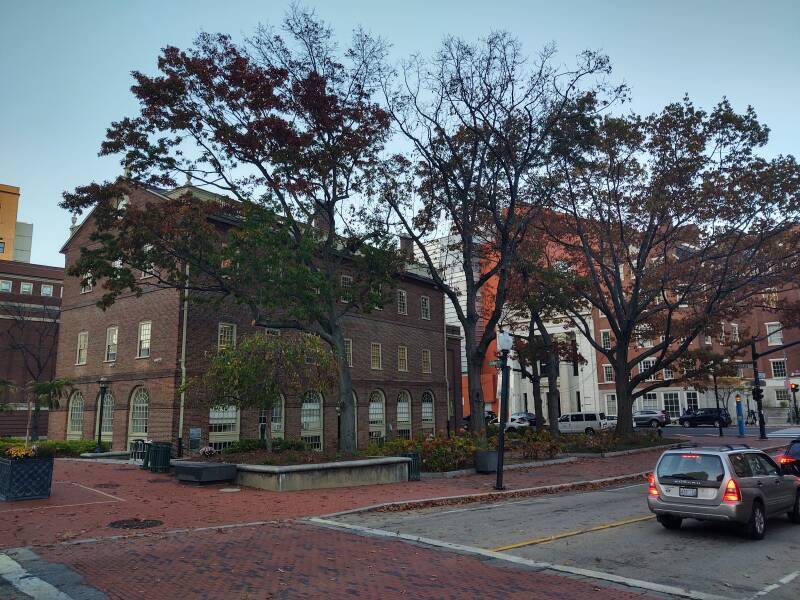
He liked mostly to reach this point in that late afternoon, when the slanting sunlight touches the Market House and the ancient hill roofs and belfries with gold, and throws magic around the dreaming wharves where Providence Indiamen used to ride at anchor After a long look he would grow almost dizzy with a poet's love for the sight, and then he would scale the slope homeward in the dusk past the old which church and up the narrow precipitous ways where yellow gleams would begin to peep out in small-paned windows and through fanlights set high over double flights of steps with curious wrought-iron railings.
— "The Case of Charles Dexter Ward", 1927, published in Weird Tales in May and July 1941.
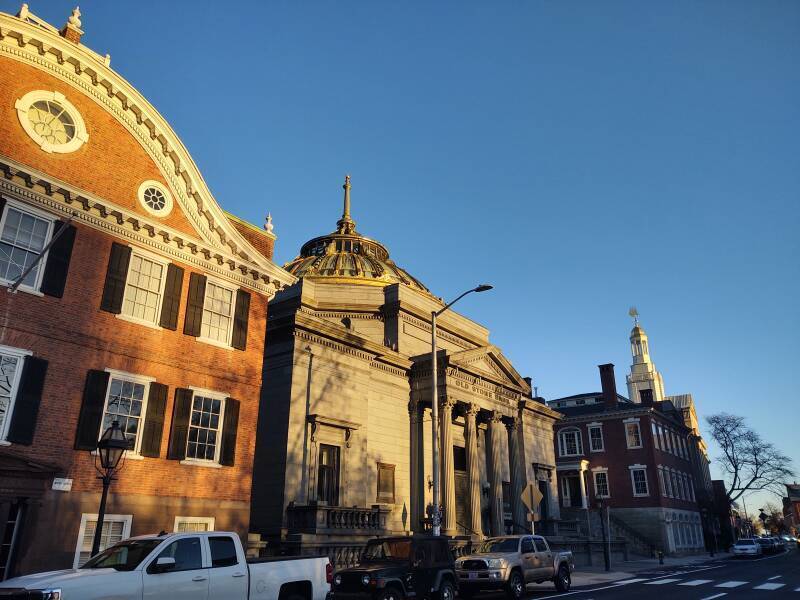
133 Prospect Street
He wrote about the "little white overtaken farmhouse" in letters to friends, while describing his neighborhood at 10 Barnes Street. It's the Jenckes-Pratt house at 133 Prospect Street, at the northeast corner with Barnes Street. In one letter:
There is a little white Colonial cottage, just renovated for an artist, only three doors away at the corner of Prospect Street, and from the upper windows one may see the great brick Halsey Mansion, built in 1801 and reputed to be haunted.
By "from the upper windows" he was referring to the house in which he lived. And in another letter:
Only three doors away is a little white farmhouse two centuries old—long overtaken by the growing city and now inhabited by an artist who still preserves a tiny patch of farmyard.

Williams Street
Williams Street was described as the home of Professor George Gammell Angell in "The Call of Cthulhu". It's south of the Brown University campus, which unusually is described as Brown and not as Miskatonic University in the story.
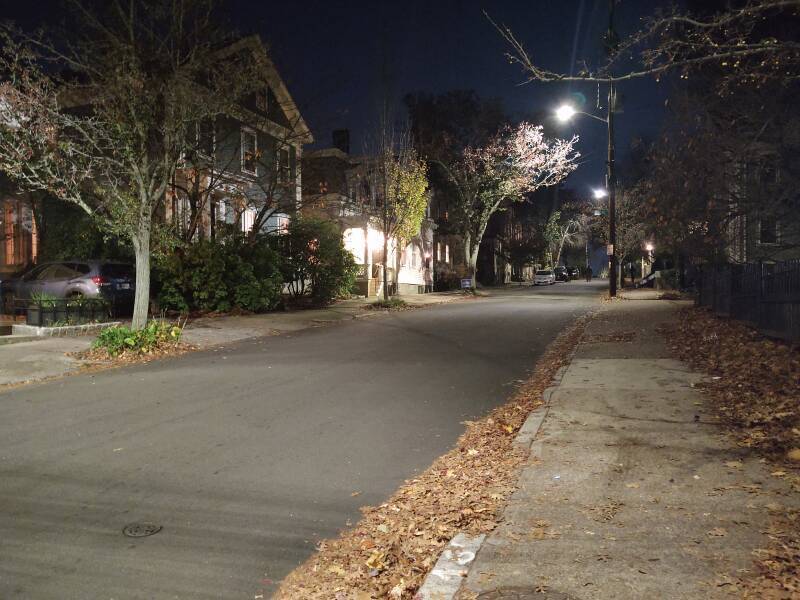
The professor had suffered a mysterious sudden death while returning home from the Newport ferry, coming up past the "queer dark courts on the precipitous hillside which formed a short cut from the waterfront to the deceased's home in Williams Street."
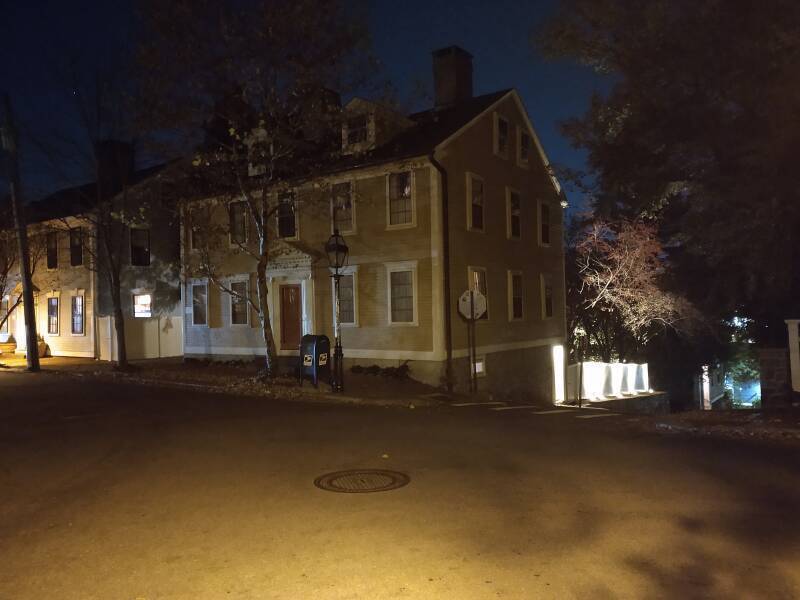
City Hall
Crossing the river leads to downtown and the City Hall.
Local dealers in drugs and scientific supplies, later questioned, gave astonishingly queer and meaningless catalogues of the substances and instruments he purchased; but clerks at the State House, the City Hall, and the various libraries agree as to the definite object of his second interest. He was searching intensely and feverishly for the grave of Joseph Curwen, from whose slate slab an older generation had so wisely blotted the name.
Little by little there grew upon the Ward family the conviction that something was wrong. Charles had had freaks and changes of minor interests before, but this growing secrecy and absorption in strange pursuits was unlike even him.
— "The Case of Charles Dexter Ward", 1927, published in Weird Tales in May and July 1941.
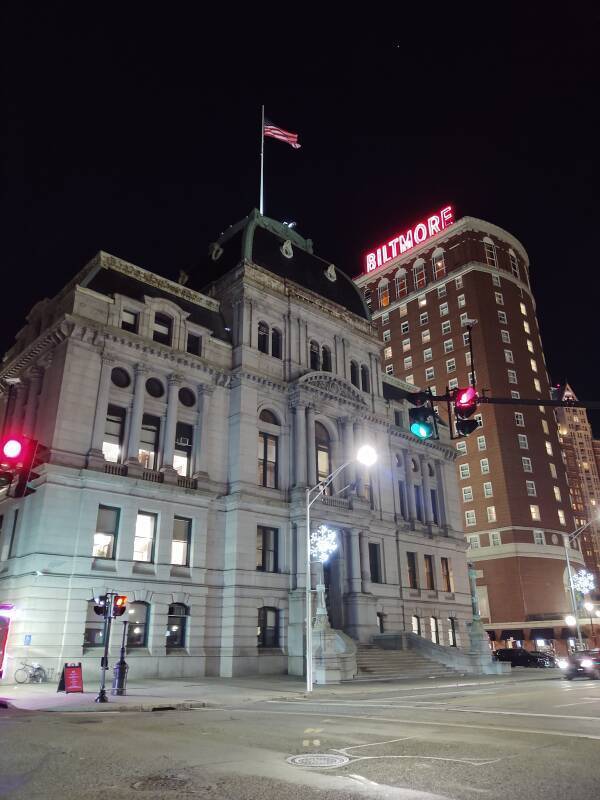
Industrial National Trust Building
The Industrial National Trust building was built in 1928. It has stood vacant since Bank of America moved out in April 2013. For some time everyone has called it the "Superman Building" because of its resemblance to the Daily Planet newspaper's building in the Superman comic book (first published in 1938, a year after Lovecraft's death), and the 1950s TV series.

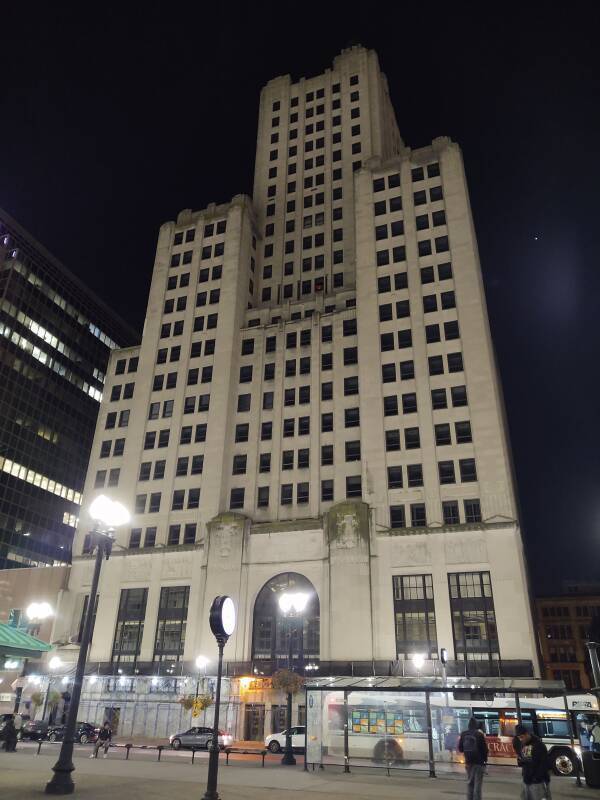
Its vacant state gives it the abandoned eldritch look of the numerous early 20th century empty buildings in Detroit.
At sunset he would often sit at his desk and gaze dreamily off at the outspread west — the dark towers of Memorial Hall just below, the Georgian court-house belfry, the lofty pinnacles of the downtown section, and that shimmering, spire-crowned mound in the distance whose unknown streets and labyrinthine gables so potently provoked his fancy. From his few local acquaintances he learned that the far-off slope was a vast Italian quarter, though most of the houses were remnant of older Yankee and Irish days. Now and then he would train his field-glasses on that spectral, unreachable world beyond the curling smoke; picking out individual roofs and chimneys and steeples, and speculating upon the bizarre and curious mysteries they might house. Even with optical aid Federal Hill seemed somehow alien, half fabulous, and linked to the unreal, intangible marvels of Blake's own tales and pictures. The feeling would persist long after the hill had faded into the violet, lamp-starred twilight, and the court-house floodlights and the red Industrial Trust beacon had blazed up to make the night grotesque.
— "The Haunter of the Dark", 1935, published in Weird Tales, December 1936.
The Lovecraft Arts and Sciences book store is nearby in The Arcade, a retail passage. They run the biannual NecronomiCon Providence conference.

Now on to the Brown University campus.